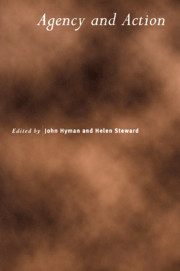Book contents
- Frontmatter
- Contents
- Preface
- Notes on Contributors
- Agency and Actions
- Two Ways of Explaining Actions
- Anscombe on ‘Practical Knowledge’
- Action, the Act Requirement and Criminal Liability
- Emotion, Cognition and Action
- Kantian Autonomy
- The Structure of Orthonomy
- Normativity and the Will
- Can Libertarians Make Promises?
- Intention as Faith
- The Destruction of the World Trade Center and the Law on Event-identity
Anscombe on ‘Practical Knowledge’
Published online by Cambridge University Press: 07 September 2010
- Frontmatter
- Contents
- Preface
- Notes on Contributors
- Agency and Actions
- Two Ways of Explaining Actions
- Anscombe on ‘Practical Knowledge’
- Action, the Act Requirement and Criminal Liability
- Emotion, Cognition and Action
- Kantian Autonomy
- The Structure of Orthonomy
- Normativity and the Will
- Can Libertarians Make Promises?
- Intention as Faith
- The Destruction of the World Trade Center and the Law on Event-identity
Summary
Among the legacies of Elizabeth Anscombe's 1957 monograph Intention are the introduction of the notion of ‘practical knowledge’ into contemporary philosophical discussion of action, and her claim, pursued throughout the book, that an agent's knowledge of what he is doing is characteristically not based on observation. Each idea by itself has its own obscurities, of course, but my focus here will be on the relation between the two ideas, how it is that the discussion of action may lead us to speak of non-observational knowledge at all, and how this notion can be part of the understanding of a kind of ordinary knowledge that we have reason to consider practical rather than speculative. Anscombe mentions several quite different things under the heading of ‘non-observational knowledge’, and she first introduces the notion of the nonobservational for purely dialectical purposes, associated with the task of setting out the field she wants to investigate, in a way that avoids begging the very questions she means to raise. She needs a way of distinguishing the class of movements to which a special sense of the question ‘Why?’ applies, but which doesn't itself employ the concepts of ‘being intentional’ or ‘acting for a reason’. Section 8 begins: “What is required is to describe this class without using any notions like ‘intended’ or ‘willed’ or ‘voluntary’ and ‘involuntary’. This can be done as follows: we first point out a particular class of things which are true of a man: namely the class of things which he knows without observation.” (p. 13) She first illustrates this by the example of knowledge of the position of one's limbs, the immediate way one can normally tell, e.g., whether one's knee is bent or not.
- Type
- Chapter
- Information
- Agency and Action , pp. 43 - 68Publisher: Cambridge University PressPrint publication year: 2004
- 27
- Cited by



